
Wine Culture and Information since 2002 - Volume 22
 Wine Culture and Information since 2002 - Volume 22 |
|
Issue 68, November 2008 |
Contents |
|
|
Alcohol-Free Wines? |
|
In the past few weeks in Italy there have been rumors about the possibility of producing alcohol-free wine or dealcoholized wine, that is a wine to which has been removed part of its alcohol. This hypothesis, supported by France and Spain in the European Union Institutions, has been cause in Italy of a long and probably useless number of debates as to be seen as a new menace for wine. Many support this initiative and say it would be useful to limit the bad and preoccupying effects of alcohol and of its dependence, in particular the tragic consequences of the actions of those deplorable subjects having the habit of drinking too much before driving a vehicle. There is no doubt every initiative taken in favor of the prevention of such grave and risky actions for the health and safety of people must be supported and spread. We are however convinced the most effective solution is a better culture and education, something which is frequently forgotten by Institutions - maybe because they are incapable or lazy - and they just believe forbidding is the best thing to do, hopefully relying in a miracle. Moreover, some support the production of alcohol-free wine as a sign of freedom of choice, a new chance offered to consumers which could also bring to the creation of a new market. No objection about this. In case there are consumers who prefer the consumption of alcohol-free wine, why should this possibility be denied to them? It is not just a matter of being moralists, it is likely a wine like this would be appreciated to those who, for reasons of personal ethics or health, cannot drink alcoholic beverages. In this sense, there is nothing negative in the possibility of offering choices: it is a sign of civility and freedom. Moreover, it is a new chance for producers who could increase their profits. In case one prefers drinking an alcohol-free wine, he or she should have the freedom to do that, likewise the same freedom must be granted to consumers who prefer drinking and choosing a wine made in a traditional way, that is, with alcohol. By considering that, we don't understand what is the problem. Many believe this initiative could represent a new attack against Italian wine, a clear attempt of adulteration by law. Indeed, no one is forbidding Italy - or any other country - to make wine the way it has always been made since thousands years, they are simply thinking about the possibility of creating a new beverage which could meet the favor of some consumers. Moreover, in case it is true adulteration is considered as a very important matter, why don't they support the initiative of making wine completely transparent to the eyes of consumers, by stating in labels the list of all the ingredients and chemical additives used in the process of production? Undoubtedly, wine is the result of a chemical process, even in case it is made with the most strict and scrupulous natural methods. Of course, not all of the chemical phenomena are the same and not all are spontaneous or natural. There are many and famous cases of adulterated products and they did no altered or menaced the dignity and the image of the real ones. Let's consider, for example, coffee, tea and beer. Since many years are being produced coffee and tea with no caffeine, as well as alcohol-free beer, nevertheless the marketing of these products has not significantly decreased. In case one wishes to have a decaffeinated coffee, despite this choice would not be agreed by a purist, why should we be scandalized by this choice? Not to mention beer. Despite many alcohol-free beers have been introduced to the market, the consumption of the beverage of Ceres is recently increased, almost reaching the consumption of wine. The taste of decaffeinated coffee is not the same of the regular coffee, as well as the taste of alcohol-free beer is not the same of traditional beer: they are in fact similar products and however different. In case there is a problem, we believe it is represented by the concrete risk of confusion. In particular, the confusion which would be arisen in case dealcoholized wine is commercialized with the name of “wine”. Wine must be wine: in case one consciously choose to have wine, this must be and represen everything wine represents since thousands years, including alcohol. Because if it is true it is right to give the freedom of choice to have an alcohol-free wine, likewise must be given the freedom of choice to have a wine with alcohol. This new product must not and cannot be called wine. If they want to create a beverage derived from wine, by using an industrial process capable of removing or reducing the alcohol produced from the fermentation of must, this cannot be called wine. Most of all in case they support the production of this beverage as a solution to limit the effects of alcohol: in order to avoid any confusion, i cannot and must not be called “wine”. Do you want to make an alcohol-free beverage derived from wine? There is no problem in this, but don't call it wine! If we consider sensorial and organoleptic aspects, it is commonly known, as well as evident, alcohol plays a fundamental role both in the balance of wine and in the gustatory and tactile perception. An alcohol-free wine would inevitably have a different taste and aroma from real wine, therefore it is a different produc and it must be treated and considered as different. Let's make things clear: we are not trying to support alcohol and its consumption, even less, its abuse. The deplorable consumption of alcoholic beverages - including wine - cannot be approved or supported: we have been always convinced the best appreciation of wine is favored by moderation. And we are also against speculations, in particular in case they are evidently adopted to confound or presume upon consumers. Even worse, in case they are used to make deplorable commercial profits. Make your alcohol-free beverage derived from wine, but let wine to always be and remain wine - with all of its alcohol, tradition and culture - because this is the way we appreciate it and want to appreciate it. With moderation, always.
|
||||
Comparing TaurasiThe king of Campania's red wines, is one of the mos famous expressions of Aglianico grape, a magnificent red wine rich in emotions and surprises |
|
Aglianico is one of the most interesting grapes of the Italian wine scene and one of its most famous sons certainly is Taurasi. Defined as the Barolo of the South, Taurasi is produced with 100% Aglianico, a wine rich and complex, with a pretty robust structure. The famous red wine of Campania - the first one of the region to be granted DOCG status (Denominazione d'Origine Controllata e Garantita, Denomination of Controlled and Guaranteed Origin) - takes its name from the homonymous town in the province of Avellino. The viticultural fame of Taurasi was mentioned by Titus Livius, who described the area as rich in vines from which was produced a precious wine for the Roman Empire. Taurasi wine was also mentioned in later centuries: Andrea Bacci - in his “Natural History of Wines” wrote in 1596 - talks about a wine produced with dried grapes and strengthened by the use of casks, aromatic and sapid, of high nutritional value and restorative for the stomach and limbs. Andrea Bacci is describing a robust and full bodied wine, just like the Taurasi we know today. Aglianico, the grape with which is produced Taurasi, is now a variety considered as autochthonous of Vulture and Irpinia areas, however its origin in from Greek, belonging to the large group of grapes ancient Greeks introduced to Italy and were generically called elleniche (Hellenics). From the word “ellenico” seems to come the word “Aglianico”, in which many recognize a corruption of the original term. The spreading of Aglianico is limited in the Southern areas of Italy, in particular Campania, Basilicata, Molise, Apulia and Calabria. Campania and Basilicata certainly are the areas in which Aglianico gives its best: Taurasi in Campania and Vulture in Basilicata. Grape rich in polyphenolic substances, Aglianico is capable of making wines of remarkable structure however having, in its youth, an appreciable crispness. Thanks to these two qualities, wines produced with Aglianico can usually stand to many years of aging and they are frequently aged in casks in order to smooth its character.
|
|
Taurasi is one of the most famous wines of Campania, among the main representatives of the wines produced with Aglianico grape. The renowned red wine of Campania - the first wine of the region to which was granted DOCG status - is produced in the entire territory of the municipality of Taurasi, in province of Avellino. Despite the production disciplinary of Taurasi allows the presence of other grapes recommended or authorized in the province of Avellino, provided they don't exceed 15%, it can be said all the Taurasi is produced with 100% Aglianico. According to the production disciplinary, Taurasi must age for at least three years before being commercialized, of which at least one in cask, whereas it takes at least four years for the “riserva” style, of which at least 18 months in cask. Cask, although it is frequently represented by barrique, is very useful for the aging of Taurasi as it favors the smoothing of Aglianico's strong character.
Besides studying Taurasi, our comparative tasting will be useful to the understanding of the role of cask in the production of this wine. Two of the wines selected for the tasting, age in barrique - although with differen periods - whereas for one of them has been used a mixed technique of aging in cask and barrique. The first wine of our tasting is Colle di San Domenico's Taurasi, aged in barrique for 24 months and for 6 in bottle. The second wine is Antonio Caggiano's Taurasi Vigna Macchia dei Goti, also in this case aged in barrique for a period of 18 months and for 18 more in bottle. The third selected wine is Mastroberardino's Taurasi Riserva Centotrenta aged for 30 months in cask and barrique to which follow at least 18 months of aging in bottle. The wines will be served at the temperature of 18°C (64°F) and will be chosen the lates vintages available on market. For the tasting, as usual, we will use three ISO tasting glasses.
|
||||||||
|
Aglianico is a grape with a pretty high content in polyphenolic and coloring substances, therefore its wine usually show intense hues and pretty low transparencies, often impenetrable to light. These characteristics can be observed in wines produced with Aglianico grapes - including Taurasi - in case are being adopted quality viticultural methods with limited grape yields in vineyard. As the production disciplinary of Taurasi provides for a minimum period of aging of 3 years before being commercialized, the color of this wine is generally intense and deep ruby red. The same color can be observed in nuances, even though in some cases, soon after being commercialized, can be observed garnet red nuances. Thanks to Aglianico's polyphenols and acidity - as well as to the good content in alcohol - Taurasi is a wine well suited for the aging in bottle, therefore developing garnet red hues and brick orange nuances. The first wine of which we will examine appearance is Colle di San Domenico's Taurasi. By holding the glass tilted over a white surface, we will evaluate the hue of wine by observing the base of the glass, where the liquid mass has the highest thickness. The color of this Taurasi is intense and brilliant ruby red, with a pretty low transparency. By observing the edge of the wine, towards the opening of the glass, we will appreciate garnet red nuances. The color of the second wine, Antonio Caggiano's Taurasi Vigna Macchia, is similar to the previous one, with an evident intense ruby red hue and low transparency, however the nuances differs from the previous wine with an evident ruby red color. The evaluation of the third wine - Mastroberardino's Taurasi Riserva Centotrenta - will show an intense and brilliant ruby red color with garnet red nuances, whereas transparency is slightly higher than the two previous wines.
|
|
The olfactory profile of Taurasi is pretty complex, with flower and fruit aromas blending with tertiary aromas derived from the aging in wood and from time. Despite Aglianico is a pretty generous grape to the nose and rich in flower and fruit aromas, in Taurasi - thanks to the aging in wood - it will be possible to find many complex aromas. Among the most frequent flower aromas in Taurasi, violet is the most evident aromatic sensation, however it is also possible to perceive dried violet and, rarely, the smell of rose. Among the mos frequent fruit aromas in Taurasi are mentioned black cherry, plum and blackberry, which represent, together with violet, the identifying qualities of this wine. With time, these aromatic qualities will be transformed in rich frui jams. Time and aging in wood allow Taurasi to develop complex aromas of leather, cocoa, coffee, chocolate, carob, vanilla, cinnamon, black pepper, clover and tobacco. Moreover, in Taurasi can also be perceived pleasing balsamic sensations of menthol. Let's begin the olfactory evaluation from Colle di San Domenico's Taurasi. By holding the glass in vertical position and without swirling, we will proceed with the evaluation of the so called opening aromas, that is the olfactory qualities identifying the wine and which can develop from the glass with a small quantity of oxygen. From the glass it will be possible the perception of plum, black cherry, blackberry and violet, the four identifying aromatic qualities of Aglianico grape and Taurasi. After having swirled the glass - in order to favor a proper oxygenation of the wine and the development of the other “heavier” aromatic substances - we will proceed with the second smell, therefore completing the olfactory profile of this first Taurasi. From the glass will be perceived aromas of blueberry, vanilla, tobacco, carob, pink pepper, cinnamon, clover and the pleasing balsamic touch of menthol. Let's proceed now with the second wine of the comparative tasting: Antonio Caggiano's Taurasi Vigna Macchia dei Goti. The opening of this Taurasi gives the nose pleasing and intense aromas of black cherry, blackberry, plum and violet, also in this case very typical of Aglianico. After having swirled the glass, we will proceed with a second smell which will complete the olfactory profile of the wine with blueberry, tobacco, vanilla, licorice, chocolate, cinnamon, clover and pleasing hints of menthol. Also the opening of the third wine - Mastroberardino's Taurasi Riserva Centotrenta - is very typical and similar to the previous wines, giving the nose aromas of plum, blackberry and black cherry. The second smell will complete the olfactory profile of the wine with dried violet, blueberry, vanilla, tobacco, licorice, leather, cocoa and mace as well as the usual balsamic touch of menthol. It should be compared the contribution of wood, the different types of casks and the different periods of aging of the three wines, in particular the complexity of tertiary aromas.
|
||||
|
Aglianico is a grape with a pretty strong character, with a high content in polyphenols and an evident acidity, qualities which require viticulturists to check the right ripening of the grape in order to avoid the production of excessively aggressive and harsh wines. For this reason, wines produced with Aglianico - including Taurasi - are being aged in wood casks in order to smooth its strong character while increasing roundness, qualities which are also mitigated by the effects of time. Aglianico has also a good content in sugar, a characteristic favoring the production of wines with pretty high alcohol volumes - even more than 14% - although this is often useful in balancing astringency and acidity. The taste of Taurasi is therefore pretty robust and complex, with an appreciable astringency and alcoholicity, where acidity - although perceptible - it is well balanced and contrast the roundness given by the aging in wood. Let's now pass to the gustatory analysis of our comparative tasting, by beginning from Colle di San Domenico's Taurasi. The attack of this first Taurasi shows the typical robust structure of the wine and an evident astringency, although balanced both by alcohol and the roundness given by 24 months of aging in barrique. It should also be noticed the role of acidity, perceptible to the taste and however balanced. Also the attack of the second wine - Antonio Caggiano's Taurasi Vigna Macchia dei Goti - is pretty astringent and tannic, with a very robust structure to which is contrasted both the alcohol and roundness, with a very balanced acidity. The attack of the third wine, Mastroberardino's Taurasi Riserva Centotrenta, confirms the character of this magnificent red from Campania, with an astringency in good evidence and a pretty robust structure, well balanced both by roundness and alcohol. It should be noticed the lower acidity of this wine as opposed to the previous wines as well as its more accentuated roundness.
|
|
Remarkable structure and appreciable acidity, well perceptible astringency and pretty high alcohol volume: it is not by chance Taurasi is sometimes defined as the Barolo of the South. Another interesting quality of Taurasi is its taste-olfactory persistence, generally being good and pretty long. The finish of Colle di San Domenico's Taurasi is persistent, leaving in the mouth pleasing and intense flavors of black cherry, plum and blackberry: a typical finish of Taurasi. The finish of Antonio Caggiano's Taurasi Vigna Macchia dei Goti is very persistent, with long flavors of blackberry, black cherry and plum, similar to the previous wine even though in this case the sensation of structure is more evident. Also the finish of the third wine - Mastroberardino's Taurasi Riserva Centotrenta - is very persistent, leaving in the mouth, just like the previous wines, long and clean flavors of blackberry, black cherry and plum, as well as a well evident sensation of structure.
|
Wines of the Month |
|
|
|
Score legend Prices are to be considered as indicative. Prices may vary according to the country or the shop where wines are bought |
|
|
|
Colli di Conegliano Rosso Ser Bele 2003 |
|
| Sorelle Bronca (Veneto, Italy) | |
| Grapes: Cabernet Franc, Cabernet Sauvignon, Merlot | |
| Price: € 25.00 | Score: |
| Colli di Conegliano Rosso Ser Bele shows an intense ruby red color and nuances of garnet red, little transparency. The nose reveals intense, clean, pleasing and refined aromas which start with hints of plum, black cherry and black currant followed by aromas of violet, vanilla, tobacco, blueberry, cinnamon, chocolate and menthol. The mouth has good correspondence to the nose, a tannic attack and however balanced by alcohol, full body, intense flavors, pleasing roundness. The finish is persistent with flavors of plum, black currant and black cherry. Colli di Conegliano Rosso Ser Bele ages for 24 months in barrique followed by 6 months of aging in bottle. | |
| Food Match: Game, Roasted meat, Braised and stewed meat, Hard cheese | |
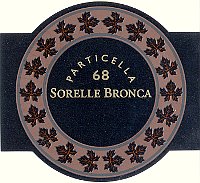
|
|
Prosecco di Valdobbiadene Extra Dry Particella 68 2007 |
|
| Sorelle Bronca (Veneto, Italy) | |
| Grapes: Prosecco (90%), Bianchetta (5%), Perera (5%) | |
| Price: € 16.00 | Score: |
| Prosecco di Valdobbiadene Extra Dry Particella 68 shows a brillian greenish yellow color and nuances of greenish yellow, very transparent, fine and persistent perlage. The nose reveals intense, clean, pleasing and refined aromas which start with hints of pear, apple and pineapple followed by aromas of acacia, jasmine, wistaria, broom, tangerine, lychee and peach. The mouth has good correspondence to the nose, a slightly sweet attack, effervescent and crisp, however balanced by alcohol, good body, intense flavors, agreeable. The finish is persistent with flavors of pear, pineapple and tangerine. | |
| Food Match: Aperitifs, Risotto with crustaceans, Sauteed crustaceans, Vegetable flans | |
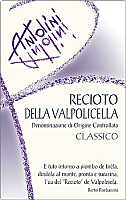
|
|
Recioto della Valpolicella Classico 2006 |
|
| Antolini (Veneto, Italy) | |
| Grapes: Corvina, Corvinone, Rondinella | |
| Price: € 25.00 - 50cl | Score: |
| Recioto della Valpolicella Classico shows an intense ruby red color and nuances of ruby red, little transparency. The nose denotes intense, clean, pleasing and refined aromas which start with hints of black cherry, blackberry and plum followed by aromas of violet, tobacco, chocolate, clover, cinnamon and menthol. The mouth has good correspondence to the nose, a sweet and tannic attack, however balanced by alcohol, full body, intense flavors, pleasing roundness. The finish is persistent with flavors of blackberry, plum and black cherry. Recioto della Valpolicella Classico ages in steel tanks. | |
| Food Match: Fruit desserts, Hard and piquant cheese | |
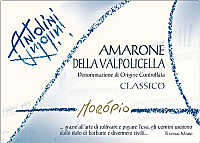
|
|
Amarone della Valpolicella Classico Moròpio 2006 |
|
| Antolini (Veneto, Italy) | |
| Grapes: Corvina, Corvinone, Rondinella | |
| Price: € 40.00 | Score: |
| Amarone della Valpolicella Classico Moròpio shows a brilliant ruby red color and nuances of garnet red, little transparency. The nose reveals intense, clean, pleasing, refined and elegant aromas which start with hints of black cherry, blackberry and violet followed by aromas of plum, blueberry, tobacco, vanilla, raspberry, cocoa, black pepper and menthol. The mouth has good correspondence to the nose, a tannic attack and however balanced by alcohol, full body, intense flavors, pleasing roundness. The finish is persistent with flavors of plum, blackberry and black cherry. A well made wine. Amarone della Valpolicella Classico Moròpio ages for 24 months in cherry wood casks followed by about 6 months of aging in bottle. | |
| Food Match: Game, Roasted meat, Stewed and braised meat, Hard cheese | |
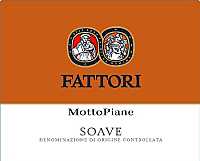
|
|
Soave Motto Piane 2007 |
|
| Fattori (Veneto, Italy) | |
| Grapes: Garganega | |
| Price: € 14.00 | Score: |
| Soave Motto Piane shows an intense golden yellow color and nuances of golden yellow, very transparent. The nose reveals intense, clean, pleasing and refined aromas which start with hints of pear, apple and peach followed by aromas of pineapple, citrus fruits, almond, medlar, hawthorn and broom. The mouth has good correspondence to the nose, a crisp attack and however balanced by alcohol, good body, intense flavors, pleasing roundness. The finish is persistent with flavors of apple, peach and plum. Soave Motto Piane ages in steel tanks. | |
| Food Match: Pasta and risotto with vegetables and crustaceans, Mushroom soups, Sauteed white meat, Sauteed fish | |
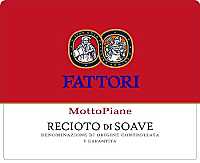
|
|
Recioto di Soave Motto Piane 2006 |
|
| Fattori (Veneto, Italy) | |
| Grapes: Garganega | |
| Price: € 20.00 - 50cl | Score: |
| Recioto di Soave Motto Piane shows a brilliant amber yellow color and nuances of amber yellow, transparent. The nose reveals intense, clean, pleasing and refined aromas that start with hints of raisin, dried fig and almond followed by aromas of dried apricot, candied fruits, honey, citrus fruit peel, nail polish and vanilla. The mouth has good correspondence to the nose, a sweet and round attack, however balanced by alcohol, good body, intense flavors, pleasing crispness. The finish is persistent with flavors of honey, raisin, candied fruits and almond. Recioto di Soave Motto Piane ages for 12 months in cask. | |
| Food Match: Fruit and cream tarts, Hard cheese | |
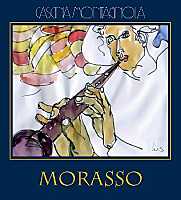
|
|
Colli Tortonesi Timorasso Morasso 2006 |
|
| Cascina Montagnola (Piedmont, Italy) | |
| Grapes: Timorasso | |
| Price: € 12.00 | Score: |
| Colli Tortonesi Timorasso Morasso shows an intense golden yellow color and nuances of straw yellow, very transparent. The nose denotes intense, clean, pleasing and refined aromas which start with hints of apple, plum and citrus fruits followed by aromas of toasted wood, hawthorn, hazelnut, vanilla and praline. The mouth has good correspondence to the nose, a crisp attack and however balanced by alcohol, good body, intense flavors, pleasing roundness. The finish is persistent with flavors of apple, citrus fruits and hazelnut. Colli Tortonesi Timorasso Morasso ages for 8 months in barrique followed by 6 months of aging in steel tanks. | |
| Food Match: Fried fish, Pasta and risotto with fish, Sauteed white meat, Sauteed fish | |
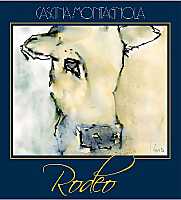
|
|
Colli Tortonesi Barbera Rodeo 2005 |
|
| Cascina Montagnola (Piedmont, Italy) | |
| Grapes: Barbera | |
| Price: € 15.00 | Score: |
| Colli Tortonesi Barbera Rodeo shows an intense ruby red color and nuances of purple red, little transparency. The nose denotes intense, clean, pleasing and refined aromas which start with hints of black cherry, plum and blueberry followed by aromas of blackberry, violet, vanilla, pink pepper, chocolate and menthol. The mouth has good correspondence to the nose, a tannic attack and pleasing crispness, however balanced by alcohol, good body, intense flavors. The finish is persistent with flavors of plum, black cherry and blueberry. Colli Tortonesi Barbera Rodeo ages for 14 months in barrique. | |
| Food Match: Roasted meat, Stewed and braised meat with mushrooms, Hard cheese | |
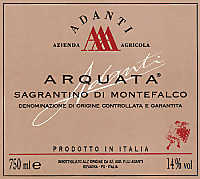
|
|
Sagrantino di Montefalco 2004 |
|
| Adanti (Umbria, Italy) | |
| Grapes: Sagrantino | |
| Price: € 20.00 | Score: |
| This Sagrantino di Montefalco shows an intense ruby red color and nuances of garnet red, little transparency. The nose reveals intense, clean, pleasing, refined and elegant aromas which start with hints of blackberry, plum and black cherry followed by aromas of violet, blueberry, vanilla, pink pepper, tobacco, cinnamon, chocolate and menthol. The mouth has good correspondence to the nose, a tannic attack and however balanced by alcohol, full body, intense flavors. The finish is persistent with flavors of plum, blackberry and black cherry. A well made wine. This Sagrantino di Montefalco ages for 28 months in cask followed by 12 months of aging in bottle. | |
| Food Match: Game, Roasted meat, Stewed and braised meat, Hard cheese | |

|
|
Sagrantino di Montefalco Passito 2003 |
|
| Adanti (Umbria, Italy) | |
| Grapes: Sagrantino | |
| Price: € 30.00 - 50cl | Score: |
| Sagrantino di Montefalco Passito shows a deep ruby red color and nuances of garnet red, little transparency. The nose reveals intense, clean, pleasing, refined and elegant aromas which start with hints of blackberry, plum jam and black cherry followed by aromas of dried violet, tobacco, vanilla, blueberry, chocolate, cinnamon, star anise, lavender, mace, nail polish and menthol. The mouth has excellent correspondence to the nose, a sweet and tannic attack, however balanced by alcohol, full body, intense flavors, pleasing roundness. The finish is very persistent with long flavors of blackberry, black cherry and plum jam. A well made wine. Sagrantino di Montefalco Passito ages for 24 months in cask. | |
| Food Match: Hard cheese, Chocolate cakes, Fruit tarts | |
News |
|
In this section are published news and information about events concerning the world of wine and food. Whoever is interested in publishing this kind of information can send us a mail to our address.
|
AquavitaeReview of Grappa, Distillates and Brandy |
|
|
| Distillates are rated according to DiWineTaste's evaluation method. Please see score legend in the "Wines of the Month" section. |

|
|
Grappa di Amarone |
|
| Antolini (Veneto, Italy) | |
| (Distiller: Distilleria Maschio Pietro) | |
| Raw matter: Pomace of Corvina, Corvinone, Rondinella | |
| Price: € 35.00 - 500ml | Score: |
| This grappa shows a pale golden yellow color, limpid and crystalline. The nose denotes intense, clean, pleasing and refined aromas of plum, blackberry, vanilla, hazelnut, licorice, chocolate, honey and dried violet, with almost imperceptible alcohol pungency. In the mouth has intense flavors with perceptible alcohol pungency which tends to dissolve rapidly, pleasing smoothness, balanced sweetness. The finish is persistent with flavors of honey, hazelnut and plum. This grappa is distilled with a discontinuous alembic still and ages in cask for about 9 months. Alcohol 42%. | |

|
|
Idôl Vodka |
|
| Idôl (Burgundy, France) | |
| Raw matter: Chardonnay and Pinot Noir grapes from Burgundy | |
| Price: € 55.00 - 700ml | Score: |
| This vodka is colorless and crystalline. The nose reveals intense, clean, pleasing and refined aromas of peanut, pear, hazelnut, raspberry and linseed oil, with almost imperceptible alcohol pungency. In the mouth has intense flavors and a dry taste, with pleasing roundness, perceptible alcohol pungency which tends to dissolve rapidly. The finish is persisten with flavors of hazelnut and pear. Vodka Idol is distilled for 7 times and filtered for 5 time. Alcohol 40%. | |
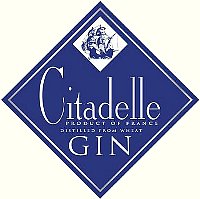
|
|
Citadelle Gin |
|
| Cognac Ferrand (Charente, France) | |
| Raw matter: 19 different spices | |
| Price: € 30.00 - 70cl | Score: |
| Citadelle Gin is colorless and crystalline. The reveals intense, clean, pleasing and refined aromas of juniper, orange peel, coriander, cardamom, star anise, violet, nutmeg, lemon peel and licorice, with almos imperceptible alcohol pungency. In the mouth has intense flavors and a dry taste, pleasing roundness, perceptible alcohol pungency which tends to dissolve rapidly, very agreeable. The finish is very persistent with long flavors of juniper, star anise and licorice. Alcohol 44%. | |
Wine Parade |
|
|
| The best 15 wines according to DiWineTaste's readers. To express your best three wines send us an E-mail or fill in the form available at our WEB site. |
| Rank | Wine, Producer | |
|---|---|---|
| 1 |
| Chianti Classico Riserva Novecento 2000, Dievole (Italy) |
| 2 |
| San Leonardo 2001, Tenuta San Leonardo (Italy) |
| 3 |
| Blanc des Rosis 2006, Schiopetto (Italy) |
| 4 |
| Bradisismo 2003, Inama (Italy) |
| 5 |
| Sforzato di Valtellina San Domenico 2002, Triacca (Italy) |
| 6 |
| Wine Obsession 2001, Vignamaggio (Italy) |
| 7 |
| Aglianico del Vulture La Firma 2004, Cantine del Notaio (Italy) |
| 8 |
| Barolo Bussia 2001, Prunotto (Italy) |
| 9 |
| Sangiovese di Romagna Superiore Riserva Thea 2005, Tre Monti (Italy) |
| 10 |
| Collio Bianco Col Disôre 2004, Russiz Superiore (Italy) |
| 11 |
| Sagrantino di Montefalco Collepiano 2003, Arnaldo Caprai (Italy) |
| 12 |
| Moscato d'Asti 2007, Vignaioli di S. Stefano (Italy) |
| 13 |
| Barolo Cannubi Boschis 2001, Sandrone (Italy) |
| 14 |
| Villa Gresti 2004, Tenuta San Leonardo (Italy) |
| 15 |
| Sforzato di Valtellina Canua 2001, Conti Sertoli Salis (Italy) |
| |||||||
Privacy Policy | |||||||


| Copyright © 2002-2024 Antonello Biancalana, DiWineTaste - All rights reserved |
| All rights reserved under international copyright conventions. No part of this publication and of this WEB site may be
reproduced or utilized in any form or by any means, electronic or mechanical, without permission in writing from DiWineTaste. |